| Listing 1 - 10 of 148 | << page >> |
Sort by
|
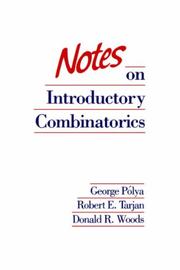
ISBN: 0817631232 9780817649531 9780817649548 9780817631239 0817631704 9780817631703 Year: 1983 Volume: 4 Publisher: Boston Birkhäuser
Abstract | Keywords | Export | Availability | Bookmark
 Loading...
Loading...Choose an application
- Reference Manager
- EndNote
- RefWorks (Direct export to RefWorks)
Developed from the authors' introductory combinatorics course, this book focuses on a branch of mathematics which plays a crucial role in computer science. Combinatorial methods provide many analytical tools used for determining the expected performance of computer algorithms. Elementary subjects such as combinations and permutations, and mathematical tools such as generating functions and Pólya's Theory of Counting, are covered, as are analyses of specific problems such as Ramsey Theory, matchings, and Hamiltonian and Eulerian paths. This introduction will provide students with a solid foundation in the subject. ---- "This is a delightful little paperback which presents a day-by-day transcription of a course taught jointly by Pólya and Tarjan at Stanford University. Woods, the teaching assistant for the class, did a very good job of merging class notes into an interesting mini-textbook; he also included the exercises, homework, and tests assigned in the class (a very helpful addition for other instructors in the field). The notes are very well illustrated throughout and Woods and the Birkhäuser publishers produced a very pleasant text. One can count on [Pólya and Tarjan] for new insights and a fresh outlook. Both instructors taught by presenting a succession of examples rather than by presenting a body of theory ¦[The book] is very well suited as supplementary material for any introductory class on combinatorics; as such, it is very highly recommended. Finally, for all of us who like the topic and delight in observing skilled professionals at work, this book is entertaining and, yes, instructive, reading." Mathematical Reviews (Review of the original hardcover edition) "The mathematical community welcomes this book as a final contribution to honour the teacher G. Pólya." Zentralblatt MATH (Review of the original hardcover edition)
Discrete mathematics --- MATHEMATICS --- Cominations --- Monograph --- Mathematics. --- Math --- Science --- Combinatorial analysis --- Combinatorial analysis.
Book
ISBN: 9781441901453 9781441901460 9781441901477 9781461424680 Year: 2010 Publisher: New York Springer
Abstract | Keywords | Export | Availability | Bookmark
 Loading...
Loading...Choose an application
- Reference Manager
- EndNote
- RefWorks (Direct export to RefWorks)
Mathematics Education and Technology-Rethinking the Terrain revisits the important 1985 ICMI Study on the influence of computers and informatics on mathematics and its teaching. The focus of this book, resulting from the seventeenth Study led by ICMI, is the use of digital technologies in mathematics teaching and learning in countries across the world. Specifically, it focuses on cultural diversity and how this diversity impinges on the use of digital technologies in mathematics teaching and learning. Within this focus, themes such as mathematics and mathematical practices; learning and assessing mathematics with and through digital technologies; teachers and teaching; design of learning environments and curricula; implementation of curricula and classroom practice; access, equity and socio-cultural issues; and connectivity and virtual networks for learning, serve to organize the study and bring it coherence. Providing a state-of-the-art view of the domain with regards to research, innovating practices and technological development, Mathematics Education and Technology-Rethinking the Terrain is of interest to researchers and all those interested in the role that digital technology plays in mathematics education.
Didactics of mathematics --- wiskunde --- Mathematics --- Math --- Science --- Computer-assisted instruction --- Study and teaching --- Study and teaching&delete& --- Curricula
Book
ISBN: 9780387922577 9780387922560 Year: 2010 Publisher: New York NY Springer New York
Abstract | Keywords | Export | Availability | Bookmark
 Loading...
Loading...Choose an application
- Reference Manager
- EndNote
- RefWorks (Direct export to RefWorks)
Spatial statistics are useful in subjects as diverse as climatology, ecology, economics, environmental and earth sciences, epidemiology, image analysis and more. This book covers the best-known spatial models for three types of spatial data: geostatistical data (stationarity, intrinsic models, variograms, spatial regression and space-time models), areal data (Gibbs-Markov fields and spatial auto-regression) and point pattern data (Poisson, Cox, Gibbs and Markov point processes). The level is relatively advanced, and the presentation concise but complete. The most important statistical methods and their asymptotic properties are described, including estimation in geostatistics, autocorrelation and second-order statistics, maximum likelihood methods, approximate inference using the pseudo-likelihood or Monte-Carlo simulations, statistics for point processes and Bayesian hierarchical models. A chapter is devoted to Markov Chain Monte Carlo simulation (Gibbs sampler, Metropolis-Hastings algorithms and exact simulation). A large number of real examples are studied with R, and each chapter ends with a set of theoretical and applied exercises. While a foundation in probability and mathematical statistics is assumed, three appendices introduce some necessary background. The book is accessible to senior undergraduate students with a solid math background and Ph.D. students in statistics. Furthermore, experienced statisticians and researchers in the above-mentioned fields will find the book valuable as a mathematically sound reference. This book is the English translation of Modélisation et Statistique Spatiales published by Springer in the series Mathématiques & Applications, a series established by Société de Mathématiques Appliquées et Industrielles (SMAI). Carlo Gaetan is Associate Professor of Statistics in the Department of Statistics at the Ca' Foscari University of Venice. Xavier Guyon is Professor Emeritus at the University of Paris 1 Panthéon-Sorbonne. He is author of a Springer monograph on random fields.
Statistics. --- Statistical Theory and Methods. --- Probability Theory and Stochastic Processes. --- Mathematical Applications in Earth Sciences. --- Econometrics. --- Math. Appl. in Environmental Science. --- Mathematical geography. --- Distribution (Probability theory). --- Mathematical statistics. --- Environmental sciences. --- Statistique --- Géographique mathématique --- Distribution (Théorie des probabilités) --- Statistique mathématique --- Sciences de l'environnement --- Econométrie --- Spatial analysis (Statistics) --- Statistik --- Raum --- Räumliche Statistik. --- Statistisches Modell. --- Mathematical models. --- Raum (Math.) --- (Math.) --- Statistik.
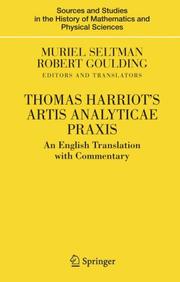
ISBN: 1280864095 9786610864096 0387495126 9780387495118 0387495118 9780387495125 1493902016 Year: 2007 Publisher: New York, NY : Springer New York : Imprint: Springer,
Abstract | Keywords | Export | Availability | Bookmark
 Loading...
Loading...Choose an application
- Reference Manager
- EndNote
- RefWorks (Direct export to RefWorks)
The present work is the first ever English translation of the original text of Thomas Harriot's Artis Analyticae Praxis, first published in 1631 in Latin. Thomas Harriot's Praxis is an essential work in the history of algebra. Even though Harriot's contemporary, Viete, was among the first to use literal symbols to stand for known and unknown quantities, it was Harriott who took the crucial step of creating an entirely symbolic algebra. This allowed reasoning to be reduced to a quasi-mechanical manipulation of symbols. Although Harriot's algebra was still limited in scope (he insisted, for example, on strict homogeneity, so only terms of the same powers could be added or equated to one another), it is recognizably modern. While Harriot's book was highly influential in the development of analysis in England before Newton, it has recently become clear that the posthumously published Praxis contains only an incomplete account of Harriot's achievement: his editor substantially rearranged the work before publishing it, and omitted sections that were apparently beyond comprehension, such as negative and complex roots of equations. The commentary included with this translation attempts to restore the Praxis to the state of Harrios draft. The authors based their work on manuscripts in the British Library, Pentworth House, and Lambeth Palace, and the commentary explores some of Harriot's most novel and advanced mathematics, very little of which has been published in the past. This publication will become an important contribution to the history of mathematics, and it will provide the basis for a reassessment of the development of algebra. The present work is the first ever English translation of the original text of Thomas Harriot’s Artis Analyticae Praxis, first published in 1631 in Latin. Thomas Harriot’s Praxis is an essential work in the history of algebra. Even though Harriot’s contemporary, Viete, was among the first to use literal symbols to stand for known and unknown quantities, it was Harriott who took the crucial step of creating an entirely symbolic algebra. This allowed reasoning to be reduced to a quasi-mechanical manipulation of symbols. Although Harriot’s algebra was still limited in scope (he insisted, for example, on strict homogeneity, so only terms of the same powers could be added or equated to one another), it is recognizably modern. While Harriot’s book was highly influential in the development of analysis in England before Newton, it has recently become clear that the posthumously published Praxis contains only an incomplete account of Harriot’s achievement: his editor substantially rearranged the work before publishing it, and omitted sections that were apparently beyond comprehension, such as negative and complex roots of equations. The commentary included with this translation relates the contents of the Praxis to the corresponding pages in his manuscript papers, which enables much of Harriot's most novel and advanced mathematics to be explored. This publication will become an important contribution to the history of mathematics, and it will provide the basis for a reassessment of the development of algebra.
Mathematics --- Equations, Theory of --- Harriot, Thomas, --- Algebra. --- History of Mathematical Sciences. --- Mathematical analysis --- Mathematics. --- History. --- Annals --- Auxiliary sciences of history --- Math --- Science
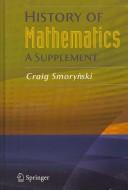
ISBN: 0387754814 0387754806 1441925937 9780387754802 9780387754819 Year: 2008 Publisher: New York, NY : Springer New York : Imprint: Springer,
Abstract | Keywords | Export | Availability | Bookmark
 Loading...
Loading...Choose an application
- Reference Manager
- EndNote
- RefWorks (Direct export to RefWorks)
This book attempts to fill two gaps which exist in the standard textbooks on the History of Mathematics. One is to provide students with material that could encourage more critical thinking. General textbooks, attempting to cover three thousand years of mathematical history, must necessarily oversimplify almost everything, the practice of which can scarcely promote a critical approach to the subject. For this reason, Craig Smorynski chooses a more narrow but deeper coverage of a few select topics. The second aim of this book is to include the proofs of important results which are typically neglected in the modern history of mathematics curriculum. The most obvious of these is the oft-cited necessity of introducing complex numbers in applying the algebraic solution of cubic equations. This solution, though it is now relegated to courses in the History of Mathematics, was a major occurrence in the history of mathematics. It was the first substantial piece of mathematics in Europe that was not a mere extension of what the Greeks had done and thus signified the coming of age of European mathematics. The fact that the solution, in the case of three distinct real roots to a cubic, necessarily involved complex numbers both made inevitable the acceptance and study of these numbers and provided a stimulus for the development of numerical approximation methods. Other unique features include: * a prefatory essay on the ways in which sources may be unreliable, followed by an annotated bibliography; * a modern recounting of a Chinese word problem from the 13th century, illustrating the need for consulting multiple sources when the primary source is unavailable; * the solution of the cubic equation, including multiple proofs that the algebraic solution uses complex numbers whenever the cubic equation has three distinct real solutions; * a critical reappraisal of Horner's Method; The final chapter contains lighter material, including a critical look at North Korea's stamps commemorating the 350th birthday of Newton, historically interesting (and hard to find) poems, and drinking songs or limericks with mathematical themes. The appendix outlines a few, small projects which could serve as replacements for the usual term papers. Craig Smorynski is also the author of "Self-Reference and Modal Logic" and "Logical Number Theory I".
Geometry --- Mathematics --- History. --- Math --- Science --- Geometry. --- Algebra. --- History of Mathematical Sciences. --- Mathematical analysis --- Euclid's Elements --- Mathematics. --- Annals --- Auxiliary sciences of history --- Histoire des mathematiques
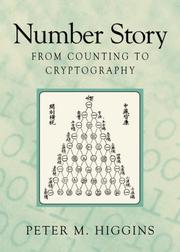
ISBN: 1281179094 9786611179090 1848000014 9781848000001 1848000006 9781848000018 Year: 2008 Publisher: London : Copernicus Books,
Abstract | Keywords | Export | Availability | Bookmark
 Loading...
Loading...Choose an application
- Reference Manager
- EndNote
- RefWorks (Direct export to RefWorks)
Numbers have fascinated people for centuries. They are familiar to everyone, forming a central pillar of our understanding of the world, yet the number system was not presented to us "gift-wrapped" but, rather, was developed over millennia. Today, despite all this development, it remains true that a child may ask a question about numbers that no one can answer. Many unsolved problems surrounding number matters appear as quirky oddities of little account while others are holding up fundamental progress in mainstream mathematics. Peter Higgins distills centuries of work into one delightful narrative that celebrates the mystery of numbers and explains how different kinds of numbers arose and why they are useful. Full of historical snippets and interesting examples, the book ranges from simple number puzzles and magic tricks, to showing how ideas about numbers relate to real-world problems, such as: How are our bank account details kept secure when shopping over the internet? What are the chances of winning at Russian roulette; or of being dealt a flush in a poker hand? This fascinating book will inspire and entertain readers across a range of abilities. Easy material is blended with more challenging ideas about infinity and complex numbers, and a final chapter "For Connoisseurs" works through some of the particular claims and examples in the book in mathematical language for those who appreciate a complete explanation. As our understanding of numbers continues to evolve, this book invites us to rediscover the mystery and beauty of numbers and reminds us that the story of numbers is a tale with a long way to run...
Number theory. --- Number study --- Numbers, Theory of --- Algebra --- Science (General). --- Mathematics. --- Popular Science, general. --- Mathematics, general. --- Number Theory. --- Math --- Science --- Popular works.
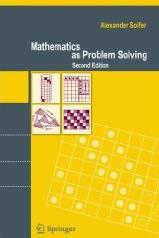
ISBN: 9780387746470 9780387746463 0387746463 0387746471 Year: 2009 Publisher: New York, NY : Springer New York : Imprint: Springer,
Abstract | Keywords | Export | Availability | Bookmark
 Loading...
Loading...Choose an application
- Reference Manager
- EndNote
- RefWorks (Direct export to RefWorks)
Retelling the best solutions and sharing the secrets of discovery are part of the process of teaching problem solving. Ideally, this process is characterized by mathematical skill, good taste, and wit. It is a characteristically personal process and the best such teachers have surely left their personal marks on students and readers. Alexander Soifer is a teacher of problem solving and his book, Mathematics as Problem Solving, is designed to introduce problem solving to the next generation. --Cecil Rousseau The American Mathematical Monthly The problems faithfully reflect the world famous Russian school of mathematics, whose folklore is carefully interwoven with more traditional topics. Many of the problems are drawn from the author's rich repertoire of personal experiences, dating back to his younger days as an outstanding competitor in his native Russia, and spanning decades and continents as an organizer of competitions at the highest level. --George Bersenyi The book contains a very nice collection of problems of various difficulty. I particularly liked the problems on combinatorics and geometry. --Paul Erdos Professor Soifer has put together a splendid collection of elementary problems designed to lead students into significant mathematical concepts and techniques. Highly recommended. --Martin Gardner To assemble so much material of the type used in Mathematical Olympiads, which has been tried and tested there, is unusual. To then present it in a form which develops themes, supported by relevant examples and problems for the reader, does the author great credit. --R. W. Whitworth The Mathematical Gazette.
Geometry --- geometrie --- algebra --- wiskunde --- Mathematics --- Discrete mathematics --- discrete wiskunde --- Algebra --- Problem solving. --- Algebra. --- Combinatorics. --- Geometry. --- Mathematics. --- Mathematics, general. --- Math --- Science --- Euclid's Elements --- Combinatorics --- Mathematical analysis
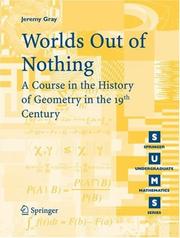
ISBN: 9781846286339 1846286336 9781846286322 1846286328 Year: 2007 Publisher: London : Springer London : Imprint: Springer,
Abstract | Keywords | Export | Availability | Bookmark
 Loading...
Loading...Choose an application
- Reference Manager
- EndNote
- RefWorks (Direct export to RefWorks)
Worlds Out of Nothing is the first book to provide a course on the history of geometry in the 19th century. Based on the latest historical research, the book is aimed primarily at undergraduate and graduate students in mathematics but will also appeal to the reader with a general interest in the history of mathematics. Emphasis is placed on understanding the historical significance of the new mathematics: Why was it done? How - if at all - was it appreciated? What new questions did it generate? Topics covered in the first part of the book are projective geometry, especially the concept of duality, and non-Euclidean geometry. The book then moves on to the study of the singular points of algebraic curves (Plücker’s equations) and their role in resolving a paradox in the theory of duality; to Riemann’s work on differential geometry; and to Beltrami’s role in successfully establishing non-Euclidean geometry as a rigorous mathematical subject. The final part of the book considers how projective geometry, as exemplified by Klein’s Erlangen Program, rose to prominence, and looks at Poincaré’s ideas about non-Euclidean geometry and their physical and philosophical significance. It then concludes with discussions on geometry and formalism, examining the Italian contribution and Hilbert’s Foundations of Geometry; geometry and physics, with a look at some of Einstein’s ideas; and geometry and truth. Three chapters are devoted to writing and assessing work in the history of mathematics, with examples of sample questions in the subject, advice on how to write essays, and comments on what instructors should be looking for. The Springer Undergraduate Mathematics Series (SUMS) is designed for undergraduates in the mathematical sciences. From core foundational material to final year topics, SUMS books take a fresh and modern approach and are ideal for self-study or for a one- or two-semester course. Each book includes numerous examples, problems and fully-worked examples.
Geometry --- Mathematics --- geschiedenis --- wiskunde --- geometrie --- Mathematics. --- Geometry. --- History. --- History of Mathematical Sciences. --- Math --- Science --- Euclid's Elements --- Annals --- Auxiliary sciences of history
Book
ISBN: 9783642006142 9783642006135 9788674663455 3642006132 9786612826498 3642006140 1282826492 8674663451 Year: 2009 Publisher: Berlin Heidelberg Springer Berlin Heidelberg
Abstract | Keywords | Export | Availability | Bookmark
 Loading...
Loading...Choose an application
- Reference Manager
- EndNote
- RefWorks (Direct export to RefWorks)
The method of wavelet transforms is one key tool in signal processing and control. Modern wavelet theory defines outlines for construction of wavelets and transformations using them. It gives rules that one has to obey to get a wavelet basis with desired properties, meaning that everyone can create a wavelet adequate for the given task. An oscillatory property and multiresolution nature of wavelets recommends them for use both in signal processing and in solving complex mathematical models of real world phenomena. This book brings to engineers and other practitioners help in understanding how wavelets work in order to be able to create new or modify the existing wavelets according to their needs and tries to satisfy different user groups. It is self contained and no previous knowledge is assumed. In seven chapters, the book gives a concise understanding of the theory of wavelets, explains how to compute them in practise and finally presents typical applications of wavelets and how they work. The book is written for graduate students and practising Engineers of electrical communications, signal processing and control.
Engineering. --- Signal, Image and Speech Processing. --- Computational Science and Engineering. --- Statistics for Engineering, Physics, Computer Science, Chemistry and Earth Sciences. --- Math Applications in Computer Science. --- Appl.Mathematics/Computational Methods of Engineering. --- Computer science. --- Engineering mathematics. --- Ingénierie --- Informatique --- Mathématiques de l'ingénieur --- Wavelets (Mathematics) --- Wavelets (Mathematics). --- Mathematics. --- Math --- Wavelet analysis --- Science --- Harmonic analysis
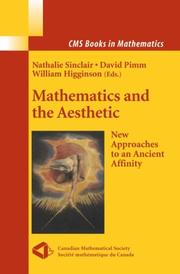
ISBN: 9780387305264 0387305262 9780387381459 1441921443 9786611141691 1281141690 0387381457 Year: 2006 Publisher: New York : Springer,
Abstract | Keywords | Export | Availability | Bookmark
 Loading...
Loading...Choose an application
- Reference Manager
- EndNote
- RefWorks (Direct export to RefWorks)
The essays in this book explore the ancient affinity between the mathematical and the aesthetic, focusing on the fundamental connections between these two modes of reasoning and communicating. From historical, philosophical and psychological perspectives, with particular attention to certain mathematical areas such as geometry and analysis, the authors examine the ways in which the aesthetic is ever present in mathematical thinking and contributes to the growth and value of mathematical knowledge. This book includes the following essays: • A Historical Gaze at the Mathematical Aesthetic, by Nathalie Sinclair and David Pimm • Aesthetics for the Working Mathematician, by Jonathan M. Borwein • Beauty and Truth in Mathematics, by Doris Schattschneider • Experiencing Meanings in Geometry, by David W. Henderson and Daina Taimina • The Aesthetic Sensibilities of Mathematicians, by Nathalie Sinclair • The Meaning of Pattern, by Martin Schiralli • Mathematics, Aesthetics and Being Human, by William Higginson • Mechanism and Magic in the Psychology of Dynamic Geometry, by R. Nicholas Jackiw • Drawing on the Image in Mathematics and Art, by David Pimm • Sensible Objects, by Dick Tahta • Aesthetics and the ‘Mathematical Mind’, by David Pimm and Nathalie Sinclair.
7.01 --- 72.01 --- Mathematics. --- Aesthetics. --- 51 --- Beautiful, The --- Beauty --- Esthetics --- Taste (Aesthetics) --- Philosophy --- Art --- Criticism --- Literature --- Proportion --- Symmetry --- Math --- Science --- Kunst (esthetica) --- Kunstesthetica --- Architectuur (esthetica) --- Architectuuresthetica --- Mathematica --- Wiskunde --- Psychology --- Aesthetics --- Mathematics --- Radio broadcasting Aesthetics
| Listing 1 - 10 of 148 | << page >> |
Sort by
|

 Search
Search Feedback
Feedback About
About Help
Help News
News